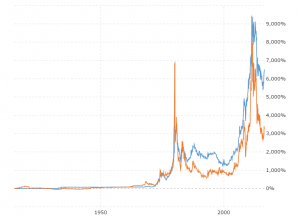37 Facts About Gold
1. Gold is so rare that the world pours more steel in one hour than it has gold since the beginning of recorded history.
2. Gold has been discovered on every continent on earth.
3. Gold melts at 2063 degrees Fahrenheit. It is an excellent conductor of heat and electricity and it never rusts.
4. The majority of gold that has been discovered throughout history is still in circulation. But it is thought that 80% of the world’s gold is still undiscovered in the ground.
5. In the early twentieth century, a French medical study suggests that gold is an effective treatment for rheumatoid arthritis.
6. Gold is so pliant that it can be made into sewing thread. One ounce of gold can be stretched over 50 miles.
7. Gold is edible. Some Asian countries put gold in fruit, jelly snacks, coffee, and tea. Since at least the 1500s, Europeans have been putting gold leaf in bottles of liquor, such as Danziger Goldwasser and Goldschlager. Some Native American tribes believed consuming gold could allow humans to levitate.
8. The largest gold nugget ever found is the “Welcome Stranger” discovered by John Deason and Richard Oates in Australia on February 5, 1869. The nugget is 10 by 25 inches and yielded 2,248 ounces of pure gold. It was found just two inches below the ground surface.
9. Gold is chemically inert, which also explains why it never rusts and does not cause skin irritation. If gold jewelry irritates the skin, it is likely that the gold was mixed with some other metal.
10. One cubic foot of gold weighs half a ton (1,000 lbs). The world’s largest gold bar weighs 200 kilograms (440 lbs).
11. In 1912, the Olympic gold medals were made entirely of gold. The gold medals from the 2014 Olympic Games in Sochi contained 6 grams of gold.
12. Around 1200 B.C., the Egyptians used unshorn sheepskin to mine for gold dust from the sands of the Black Sea. This practice is most likely the inspiration for the “Golden Fleece.”
13. There are more than 400 references to gold in the Bible, including specific instructions from God to cover furniture in the tabernacle with “pure gold.” Gold is also mentioned as one of the gifts of the Magi.
14. Between A.D. 307 and 324, the worth of one pound of gold in Rome rose from 100,000 denarii (a Roman coin) to 300,000 denarii. By the middle of the fourth century, a pound of gold was worth 2,120,000,000 denarii—an early example of runaway inflation, which was partly responsible for the collapse of the Roman Empire.
15. Originally the U.S. mint made $2.50, $10, and $15 coins of solid gold. Minting of gold stopped in 1933, during the Great Depression.
16. The San Francisco 49ers are named after the 1849 Gold Rush miners.
17. Gold and copper were the first metals to be discovered by humans around 5000 B.C. and are the only two non-white-colored metals.
18. The value of gold has been used as the standard for many currencies. After WWII, the United States created the Bretton Woods System, which set the value of the U.S. dollar to 1/35th of a troy ounce (888.671 mg) of gold. This system was abandoned in 1971 when there was no longer enough gold to cover all the paper money in circulation.
19. The world’s largest stockpile of gold can be found five stories underground inside the Federal Reserve Bank of New York’s vault and it holds 25% of the world’s gold reserve (540,000 gold bars). While it contains more gold than Fort Knox, most of it belongs to foreign governments.
20. The “troy ounce” of gold comes from the French town of Troyes, which first created a system of weights in the Middle Ages used for precious metals and gems. One troy ounce is 480 grains. A grain is exactly 64.79892 mg.
21. The gold standard has been replaced by most governments by the fiat (Latin for “let it be done”) standard. Both Thomas Jefferson and Andrew Jackson strongly opposed fiat currency. Several contemporary economists argue that fiat currency increases the rate of boom-bust cycles and causes inflation.
22. The Mines of South Africa can descend as far as 12,000 feet and reach temperatures of 130°F. To produce an ounce of gold requires 38 man hours, 1400 gallons of water, enough electricity to run a large house for ten days, and chemicals such as cyanide, acids, lead, borax, and lime. In order to extract South Africa’s yearly output of 500 tons of gold, nearly 70 million tons of earth are raised and milled.
23. Only approximately 142,000 tons of gold have mined throughout history. Assuming the price of gold is $1,000 per ounce, the total amount of gold that has been mined would equal roughly $4.5 trillion. The United States alone circulates or deposits over $7.6 trillion, suggesting that a return to the gold standard would not be feasible. While most scholars agree a return to a gold standard is not feasible, a few gold standard advocates (such as many Libertarians and Objectivists), argue that a return to a gold standard system would ease inflation risks and limit government power.
24. The first recorded gold ever discovered in the United States was was a 17-pound nugget found in Cabarrus, North Carolina. When more gold was discovered in Little Meadow Creek, North Carolina, in 1803, the first U.S. gold rush began.
25. In 1933, Franklin Roosevelt signed Executive Order 6102 which outlawed U.S. citizens from hoarding gold. Owning gold (except for jewelers, dentists, electricians, and other industry workers) was punishable by fine up to $10,000 and/or ten years in prison.
26. The purity of gold is measured in carat weight. The term “carat” comes from “carob seed,” which was standard for weighing small quantities in the Middle East. Carats were the fruit of the leguminous carob tree, every single pod of which weighs 1/5 of a gram (200 mg).
27. Carat weight can be 10, 12, 14, 18, 22, or 24. The higher the number, the greater the purity. To be called “solid gold,” gold must have a minimum weight of 10 carats. “Pure gold” must have a carat weight of 24, (though there is still a small amount of copper in it). Pure gold is so soft that it can be molded by hand.
28. Nearly all of the gold on Earth came from meteorites that bombarded the planet over 200 million years after it formed.
29. Malleability is a measure of how easily a material can be hammered into thin sheets. Gold is the most malleable element. A single ounce of gold can be beaten out into a sheet that is 300 square feet. A sheet of gold can be made thin enough to be transparent. Very thin sheets of gold may appear greenish blue because gold strongly reflects red and yellow.
30. Although gold is a heavy, dense metal, it is generally considered non-toxic. Gold metal flakes may be eaten in foods or drinks.
31. There is an estimated total of 10 billion tons of gold in the world’s oceans. That is 25 tons of gold for every cubic mile of seawater.
32. Oceans are the greatest single reservoir of gold at Earth’s surface, containing approximately eight times the total quantity of gold mined to date. However, the current cost of extracting it is more than the gold is worth.
33. There are 92 naturally occurring elements found in the earth’s crust. Gold ranks 58th in rarity.
34. Two-thirds of the world’s gold comes from South Africa.
35. South Dakota and Nevada produce more gold than any other states.
36. Scientists believe that gold can be found on Mars, Mercury, and Venus.
37. The visors of astronauts’ helmets are coated in a very thin, transparent layer of gold (.000002 inches) that reduces glare and heat from sunlight.
Sources:
https://facts.randomhistory.com/2009/03/09_gold.html
https://www.investinganswers.com/investment-ideas/commodities-precious-metals/50-surprising-facts-you-never-knew-about-gold-1370
https://www.amnh.org/exhibitions/past-exhibitions/gold/eureka/gold-fun-facts









